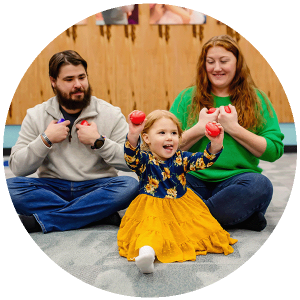You’re sitting in your Music Together® class, and your teacher sings, “Oh, John the Rabbit.” In response, you sing, “Yes ma’am!” A little later on, your teacher might split the room in half, with one half singing the verse and the other singing the answer. In both experiences, you have to listen closely and wait until it’s your turn to sing. It might be a bit difficult to stop yourself from singing the whole song (especially for young children), but you do your best. This experience gives everyone great practice in inhibitory control!

You might remember a recent post citing inhibitory control as one of several executive function skills that Music Together classes naturally support. In an interview, Music Together coauthor and Director of Research, Lili M. Levinowitz, Ph.D., explained that inhibitory control is the ability to delay or inhibit an impulsive response in order to act in a more appropriate way for a given situation. This skill includes the ability to filter distractions, think before acting, and resist temptation (like peeking at your presents before your birthday!). Research has shown that all executive function skills are essential to success in school and life. (Imagine getting through a day at work or school without inhibitory control. . .)
Music activities that support your child’s development
Many song activities in the Music Together curriculum give children a chance to practice inhibitory control as they also develop musically. For instance, this session you’ll learn our version of the classic fingerplay, “The Snail and the Mouse.” Your teacher might creep their hand on the floor, or up and down their arm, to depict the slow snail, as they lead you in chanting, “Slowly, slowly, very slowly, creeps the garden snail. Slowly, slowly, very slowly, up the wooden rail.” Then, there is a big pause. That big pause is where the magic happens. Your teacher might take and hold a deep breath while everyone in class prepares for the quick mouse to come out. In the space between the agonizingly slow snail and the quick mouse, you are called to listen and wait before the whole class chants, “Quickly, quickly, very quickly, runs the little mouse! Quickly, quickly, very quickly, in his little house!” Yup. That’s inhibitory control at work.
Practice makes progress
Songs and chants like “John the Rabbit” and “The Snail and the Mouse” allow children to learn and practice new skills (including, in these cases, inhibitory control) in an engaging, enjoyable way. And the learning doesn’t stop in class. You can reinforce the skill of inhibitory control at home with simple call-and-response activities. You might engage your child as you sing, “Let’s tie our shoes now,” and have them or another adult in the room sing, “Yes, ma’am!” You might also chant, “Slowly, slowly, very slowly, we climb up the stairs.” Then, of course, take a deep breath, pause, and say, “Quickly, quickly, very quickly, we slide down the slide!”
Your child is never too young to start making music and reaping the developmental benefits. Early exposure and lots of opportunities to practice skills forms a strong foundation that children can build on for the rest of their lives. In fact, when it comes to executive functions, we adults can benefit from practicing, them, too! Think about using inhibitory control to actually only watch one more episode of your favorite show.
“Yes, ma’am!”



